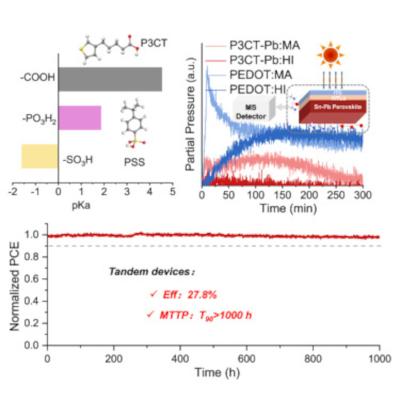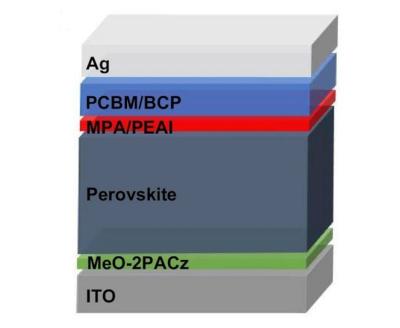Perovskite Solar - Page 13
NREL team evaluates sustainability pathways for perovskite photovoltaics
Researchers at NREL have examined how metal halide perovskite photovoltaics (MHP-PV) could scale a sustainable supply chain while appreciably contributing to a global renewable energy transition. They evaluated the critical material concerns, embodied energy, carbon impacts and circular supply chain processes of MHP-PVs.
Perovskite-based solar panels may play an important role amid global decarbonization efforts to reduce greenhouse gas emissions. As the technology emerges from the testing stages, scientists are assessing how best to design the solar panels to minimize their impact on the environment decades from now.
Researchers eliminate grain surface concavities to obtain improved perovskite thin-film interfaces
Researchers at Hong Kong Baptist University, The Hong Kong University of Science and Technology (HKUST) and Yale University have revealed the existence of surface concavities on individual crystal grains that are the fundamental blocks of perovskite thin films, and examined their significant effects on the film properties and reliability.
Based on this discovery, the team designed a new way of making perovskite solar cells (PSCs) more efficient and stable via a chemo-elimination of these grain surface concavities.
First Solar commissions huge solar R&D center
Prominent U.S solar panel maker, First Solar (Nasdaq: FSLR), is reportedly building a new research and development (R&D) innovation center in Lake Township, Ohio, believed to be the largest facility of its kind in the Western Hemisphere - The Jim Nolan Center for Solar Innovation. The new center is part of an approximately half-billion dollar investment by First Solar in R&D infrastructure, and the company expects to also commission a perovskite development line at its Perrysburg, Ohio, campus in the second half of 2024.
The facility covers 1.3 million square feet and includes a high-tech pilot manufacturing line allowing for the production of full-sized prototypes of thin film and tandem PV modules. Prior to the commissioning of the Jim Nolan Center, First Solar utilized a manufacturing line at its Perrysburg facility for its late-stage product development efforts. This arrangement limited the flexibility for development efforts and created constraints when mission-critical tools had to go offline. By resolving these limitations and constraints, the new facility is expected to accelerate innovation cycles.
EneCoat Technologies raises Series C funding of over USD$35 million
INPEX CORPORATION, a large Japanese exploration and production (E&P) company, has announced it has made an investment in EneCoat Technologies, a Kyoto University-based startup company that develops next-generation perovskite solar cells. This is part of a series C round that totaled in 5.5 billion yen (around USD$35 million) and was led by Toyota’s growth fund, Woven Capital and and Mitsubishi HC Capital (in addition to INPEX). Existing investors Mirai Creation Fund III and Kyoto University Innovation Capital participated in the round, bringing the total funding raised to over 8 billion yen (over USD$50 million).
As perovskite solar cells use iodine compounds as raw materials, INPEX is well positioned to tap synergies in terms of raw material supply through its operations at the Naruto Gas Field in Chiba Prefecture, a water-soluble gas field where subsurface brine water is used to produce iodine following the extraction of natural gas.
Researchers examine barrier reinforcement for enhanced perovskite solar cell stability under reverse bias
Researchers at the National Renewable Energy Laboratory (NREL) and University of North Carolina at Chapel Hill have reported a systematic study on the degradation mechanisms of p–i–n structure perovskite solar cells (PSCs) under reverse bias. Reverse bias is a phenomenon that can occur when, for example, an individual cell is shaded and other cells in the module try to push a higher current through it, increasing the temperature and potential damage to the cells. These conditions make solar cells unstable and deteriorate their performance over time.
The team's new strategy could improve the stability of PSCs under reverse bias conditions and facilitate the future deployment of perovskite-based photovoltaics (PVs) in real-world settings.
Singfilm Solar announces 22.6% efficiency for perovskite solar module
Singapore-based startup Singfilm Solar has announced it achieved a power conversion efficiency of 22.6% for a p-i-n structure perovskite solar panel. The result was said to be confirmed by China's National PV Industry Measurement and Testing Center (NPVM).
The design of the mini modules includes eight sub-cells connected in series on a 55 mm × 55 mm substrate, each sub-cell with a width of 5.6 mm. Each sub-cell within the module reportedly demonstrates impressive performance metrics with an open-circuit voltage of 1.169 V, a short-circuit current of 25 mA/cm², and a fill factor of 77.4%.
Researchers develop method for more stable all-perovskite tandem solar cells
Researchers at The University of Toledo (UToledo), Northwestern University and University of Washington have focused on the stability of perovskite solar cells, and reported an adjustment to the chemical structure of a key component of a tandem cell that allows it to continuously generate electricity for more than 1,000 hours.
Image from Joule
“State-of-the-art all-perovskite tandem cells with a conventional hole-transfer layer can only continuously operate for hundreds of hours,” said Dr. Zhaoning Song, a co-author and assistant professor in the Department of Physics and Astronomy at UToledo. “Our innovation prolongs the stability of these devices, advancing all-perovskite tandem technology and bringing it closer to practical application.”
Researchers develop a crystal capping layer to enable the formation of black-phase FAPbI3 perovskites in humid air
Researchers from Peking University, Tsinghua University, Beijing Institute of Technology and Ecole Polytechnique Fédérale de Lausanne (EPFL) have tackled a reproducibility challenge in black-phase formamidinium lead iodide (α-FAPbI3) perovskites. They explained that while this is the desired phase for photovoltaic applications, water can trigger formation of photoinactive impurity phases such as δ-FAPbI3. The team found that the classic solvent system for perovskite fabrication exacerbates this reproducibility issue.
Growth of the photoactive black phase of formamidinium lead iodide (α-FAPbI3) usually requires dimethyl sulfoxide solvent, but the hygroscopic nature of this chemical also promotes water-induced degradation to the photoinactive phase. the scientists showed that a larger chlorinated organic molecule can form a hydrophobic capping layer that enables perovskite crystallization under humid conditions by protecting growing crystallites from water.
Researchers design efficient inverted perovskite solar cells using a synergistic bimolecular interlayer
A team of researchers, led by the Fudan University in China, has developed a p-i-n structure inverted perovskite solar cell that uses a synergistic bimolecular interlayer (SBI) and achieves what the team says is the smallest nonradiative recombination induced open-circuit voltage loss ever reported.
Schematic illustration of p-i-n PSC using MPA/PEAI as SBI. Image from Nature Communications
The researchers' SBI strategy consisted of depositing 4-methoxyphenylphosphonic acid (MPA) and 2-phenylethylammonium iodide (PEAI) as modulators to functionalize the perovskite surface.
Researchers show how 2D perovskitoids enhance stability in perovskite solar cells
Researchers from Northwestern University, University of Toronto and KAUST have hypothesized that perovskitoids, with robust organic-inorganic networks enabled by edge- and face-sharing, could impede ion migration. This addresses the issue of the migration of cations between 2D and 3D layers which results in the disruption of octahedral networks that leads to degradation in performance over time
The scientists explored a set of perovskitoids of varying dimensionality, and found that cation migration within perovskitoid/perovskite heterostructures was suppressed compared to the 2D/3D perovskite case. Increasing the dimensionality of perovskitoids improves charge transport when they are interfaced with 3D perovskite surfaces – the result of enhanced octahedral connectivity and out-of-plane orientation.
Pagination
- Previous page
- Page 13
- Next page





